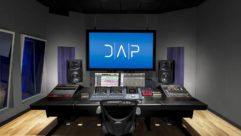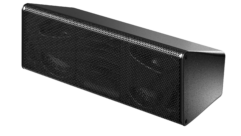
Installation Profile:
Total Home Control
Aug 1, 2006 12:00 PM,
By Jack Kontney
Control simplicity dominates a complex residential installation.
An integrated control system built around Crestron products kept electronics out of sight and allowed the Weinbergs to preserve the aesthetic of their home as a display space.
Photos courtesy of M. Alan Associates. Photos by Stephen Gladfelter
We’ve all heard the stories and seen the pictures—the Hollywood producer’s home screening room, the Bill Gates “home of the future,” etc. These proverbial residential playgrounds for the rich and famous are designed and driven by an insatiable need to have ultimate control over one’s environment. It all sounds very glamorous, but it’s also very rare and complicated to implement.
Systems designers and integrators in the commercial world, of course, are used to this sort of thing in corporate environments. Boardrooms, churches, nightclubs, and stadiums are all designed with a mandate to provide the best AV capabilities in the world, with total control for the user — over audio, video, conferencing and presentations, lighting, security, HVAC, computers, and much more.
On a hardware level, there’s a lot of similarity between commercial and residential scenarios. But there is also a growing degree of separation between these two worlds. In fact, the number of integrators who work both sides of the street these days is relatively small, and shrinking.
Irwin and Barbara Weinberg’s new residence in Cincinnati exemplifies this trend. The architecturally interesting pod-style ranch design was inspired by the work of architect Hugh Newell Jacobsen and finalized by local firm Architects Plus. The owners are older and, by their own admission, not the best candidates for high-end technology in a whole-home system.
The designer and installer is Cincinnati’s M. Alan Associates, a firm that has specialized in custom high-end residential systems for 17 years. Partner Mark Laine says, “This project came to us when we were contacted by an architectural firm and the builder for information on Lutron shades on behalf of their client. It’s funny sometimes how these things get started.”

SELLING THE CONCEPT
In planning their new home, Irwin and Barbara Weinberg had seen an ad for the Lutron QED (Quiet Electronic Drive), a silent window shading system. This raised the possibility of doing a full home systems integration job on the home, which, in turn, led to a meeting between M. Alan Associates and the Weinbergs.
“Their attitude was very typical of our customers at the beginning,” says Laine. “There is some trepidation that they’ll buy this expensive system, and then not be able to use it.”
The Weinbergs’ experience in the M. Alan showroom sold them on the concept. “We must have spent three hours there,” Irwin recalls. “We saw the things they could do, and it just blew us away. At that time, I just really wanted to play my CDs throughout the house, and also have the option of listening to FM radio. But when we saw what else we could do, it was really fascinating.”
“They knew they’d have music in their new home,” Laine says. “When they talked about putting a plasma TV above the fireplace, we started to talk about the real mundane things that it takes to make that happen — questions like where the cable box goes. That was our opportunity to show them a fully integrated, house-wide system.”
Laine explained to the Weinbergs how a central location for all audio and video components could enable distribution to any location. “That was a big deal,” he notes. “And when they saw how they could integrate control of multiple furnaces, see who’s at the front door, and change the lighting all from one system, they had a strong interest.”

The key to engaging the customer, according to Laine, is to make them aware of what’s possible, and how easy it can be to operate. Irwin Weinberg agrees with that assessment. “In my mind, the most appealing feature of this is the simplicity involved, the ease of operation,” he says. “And the clean look about it, too. You don’t have wall switches all over the place. It isn’t necessary.”
“Ease of operation is a key point,” Laine agrees. “A lot of our clients express the same concern to me. If they can just click a button and get right to what they want, then they like it. But if they have to click through four or five menus, that’s way too much. All the stuff we do, it dwells in the background. We actually work at hiding our talent. And that’s what sells them.”
Rather than displaying an array of products, M. Alan Associates’ showroom focuses on lifestyle — a home environment that includes the full integration of audio, video, lights, shades, security systems, and HVAC.
“It’s what we refer to as control system overlay,” Laine explains. “Using Crestron product, we can demonstrate a seamless integration of all those technologies from a touchpanel. They see no technology other than that little box they have in their hand.”

Rather than emphasize the vast abilities of today’s high-end products, Laine took a cue from the automotive world for his showroom.
“We thought about how people interact with their car stereos, and how simple it is,” he says. “They don’t have to know anything about it, they just hit a button and they’re done. We try to recreate and enhance that experience for the home environment.”
As a result, M. Alan has worked to simplify touchscreen interfaces, customizing them with labels that are intuitively easy to understand. The success of this approach is clear both in the showroom and in the end result inside the Weinbergs’ home.

FROM SHADES TO SYSTEM
As longtime collectors of contemporary art, the Weinbergs wanted their home to function as a display space, as well as a place to live and entertain. To maintain focus on their artwork, it was essential that all electronics remain out of sight as much as possible. This aesthetic was applied throughout the home, from lights to audio to video.
A ranch-style home with a full basement, the Weinberg home’s primary living area includes a living room, formal dining room, hearth room, and kitchen. In addition, there is a master suite with separate full bathrooms, an office, and, in the basement, a full media room. A guest wing also houses four more bedrooms. Just off the media room, in an unfinished area of the basement, two Middle Atlantic Slim 5 Series racks with RSH Series shelving units hold the system’s control center. At the heart of the system is Crestron equipment, including a Pro2 processor augmented by an array of amps, controllers, servers, and interfaces. Audio distribution is handled via two Crestron servers, a bidirectional CNX-BIPAD8 and a CNX-PAD8A, which send audio to 16 zones throughout the house. Crestron’s CNX-PVID 8×3 server routes component, composite, and S-Video sources with equal aplomb. A pair of Crestron CNAMPX 16×60 amplifiers provides power for the loudspeakers hidden throughout the house. The entire setup is protected by a SurgeX SX2120 power controller, with an APC battery backup system ensuring uninterrupted power to vital system components.
Sources housed in the control center include two Crestron tuners (FM and XM Radio). A DTR-10.5 home theater receiver and a DPS-10.5 universal DVD player from Integra serve the adjoining media room, ensuring that no AV hardware intrudes into the viewing area. This is also where the master cable box resides.
In terms of control, the starting point is in the kitchen — the first room the Weinbergs enter from the garage. There, a wall-mounted, 12in. master control panel, the Crestron TPS-4500LV, gives instant access to every piece of system hardware in the house. One-touch buttons provide system access to audio, video, lighting, HVAC (“climate”), and the security system (“cameras”). The screen’s generous real estate also allows it to function as a television.
To ensure the level of convenience that the Weinbergs required, Crestron STX-1700CXP handheld wireless touchpanels reside on charger docks in the hearth room, media room, and master bedroom. These communicate with the basement nerve center via hidden TPS-RFGWX wireless gateways that operate via spread spectrum technology in the 2.4GHz band. In addition, three strategically located TPS-2000L touchpanels and three C2N-DB12 wall-mounted touchpads provide additional access around the house.

The basement control center for the lighting and shading systems includes a Lutron HomeWorks processor and Q96 QED shade interface, plus power supplies and dimming modules.
AUDIO, VIDEO, AND MORE
In keeping with the desired aesthetic of the home, all loudspeakers are hidden. Similarly, the only visible component of the three television systems are the screens themselves and, of course, the touchpanel controllers.
In the hearth room, a Chief PLP-2023 tilt wall mount holds a 50in. Fujitsu Plasmavision HD screen mounted on the wall above the fireplace. The room’s Integra DPS-5.5 DVD player is hidden away in a cabinet, with component video routed to the screen via a Crestron RMCLV room box. The DVD audio is routed via the basement server system, returning to feed the Fujitsu speaker system, along with a pair of Sound Advance SA2 loudspeakers in the ceiling. When only audio is being served, only the ceiling speakers are active.
“The Sound Advance SA2 is a unique product in that there is no visible grille or opening,” notes Laine. Instead, the 14″×21″ panel radiates sound in a 140-degree pattern. These speakers will accept paint, plaster, or wallpaper coverings, allowing them to be fully integrated into the room décor, while still providing excellent fidelity.
In the master suite, the bedroom follows the hearth room recipe, with another wall-mounted 50in. Fujitsu HD plasma, and a pair of Sound Advance SA2 speakers. Irwin and Barbara each have a separate full bathroom, and each of those is equipped with Crestron controllers and audio systems, including Sonance shower speakers.
“It really is nice,” Irwin says. “You don’t miss a beat. I like to listen to public radio in the morning, and it’s nice that I don’t miss out on it when I’m in the shower.”

The media room’s hidden 5.1 surround system includes a James Power-Pipe 1000 subwoofer in a floating, wall-mounted cabinet with bass pumped through an invisible vent in the base of the unit.
Irwin’s home office is primarily notable for its computer system. It, too, is fully integrated with the rest of the house.
“I love that I can call the system up on my computer with a mouse click,” he says. “I can turn on XM Radio, lower or raise the shades in my office, control the climate, look at my security cameras — all while I’m sitting here in my office working. I just click the mouse, and, boom, there it is.”
The home’s video showpiece is the home theater system found in the basement. On the wall, a 106in. HD Cinema Vision screen from Da-Lite dominates. The picture is provided by an iVision HD DLP projector from Digital Projection, hung with a Chief RPA-034 inverted ceiling mount and hidden from view within a soffit in the ceiling.
The 5.1 surround sound is all hidden, but without compromising quality. The LCR sources are Sonance Ellipse 2.0 speakers, with a pair of Sonance RS-2 models providing rear surround. All the Sonance speakers are ceiling mounted. The subwoofer, a James PowerPipe 1000, is secreted in a floating, wall-mounted cabinet, with bass pumped through an invisible vent in the base of the unit. The Integra DVD player is housed in the adjoining room, and everything is controlled from a wireless Crestron touchpanel. The result is a system with no visible hardware beyond the massive screen on the wall, yet without any compromises in the quality of the sound and picture.
The house’s many large windows were literally the starting point from which the entire integration project flowed. With about three dozen pieces of hanging art, plus sculptures throughout the house, lighting control was essential. The lighting is from the Lutron HomeWorks collection, with SeeTouch keypads offering instant control of multiple lighting scenarios within the rooms. The 23 windows are covered by Lutron QED shades, requiring three QED power panels and integrated into the home’s Crestron system with the HWI-Q96 shade interface.
Because the Weinbergs do a lot of entertaining, one of the system control functions is labeled “entertain.” When this is activated, lights come on in every room. Just outside, a Japanese maple paired with a whimsical piece of sculpture are highlighted.
At the same time, audio is activated in all the public rooms, including the dining room and living room.
Again, the speakers of choice are the Sound Advance SA2 units, with two above the ceiling in the dining room and four more covering the living room. Additionally, a pair of Sonance speakers is deployed for those who wander outside.
Security and communication are also included in this installation. The grounds are watched by four strategically placed GE/Honeywell Outdoor Day/Nite color cameras. These are viewable from any Crestron touchpanel or television.
“It’s really nice and really easy,” Irwin says. “Wherever I am, I just hit a button to see who’s at the door.”
Of course, the Weinberg’s phone technology — a Panasonic Digital Hybrid Wireless system — is deployed throughout the house, as well. Four wireless handsets and eight speakerphones ensure that a phone is always at hand. The system is also set up as an intercom.

Two Middle Atlantic racks and shelving units housing the system’s Crestron control center serve the adjoining media room without intruding into the viewing area.
MAKING IT EASY
Laine knows his customer base. They’ve been exposed to a lot of advertising telling them to run down to the local megastore to buy the latest high-definition TV and surround system, and many of them have been burned over the years.
“They buy this stuff, they take it home, and they can’t make it work,” he notes. “And they assume it’s their own shortcomings. But it’s gotten a lot more complicated, with different audio and video technologies. Frankly, it’s just not going to be seamless unless somebody takes a stand.”
Laine says, therein lies the difference between success in the commercial AV industry and residential systems integration.
“We’ve worked around a lot of [commercial] integrators, and nine times out of 10, they will have the technology nailed,” he says. “But their interfaces usually leave a lot to be desired. And the reason would be, they’re doing it in somebody’s workplace. There’s somebody whose job it is to learn how to operate the new equipment. But in somebody’s home, it’s a truly different animal. People just want to relax.”
Even enthusiastic customers like Irwin and Barbara experienced a degree of trepidation before actually moving into their new home. Now, they say they are, indeed, relaxed. “At first we thought, ‘Oh man, it’s really going to be hard to run this thing.’ But I was just amazed,” says Irwin Weinberg. “We were only here about two or three days, and we had it under control. Not a problem.”
Laine says the key is investing time in the initial discovery phase, learning what customers want and will actually use.
“We could let that wireless touchpanel control their whole world,” he says, “but that’s not really the intent. We’ve spent a lot of time and effort over the years to create our own interfaces and streamline the process for people. It’s really a form-follows-function thing.”
If the Weinbergs are typical residential customers, M. Alan Associates has found a winning formula.
“We’ve been here nine months, and I’m really happy with the way things are right now,” Irwin says. “After using the home systems for [at press time] nine months, I feel like Mark helped us think of everything we need. There’s nothing that we miss, and we don’t seem to have any stuff that we don’t use. Looking back, I think we would be remiss not to have done this. Of course, it does come with a healthy price tag, but in the end it is absolutely worth it. It enhanced the whole sex appeal of the house and makes it much more enjoyable and fun to be in, and isn’t that what it’s all about?”
Listening to this comment, Laine smiles. “That’s how I know when we’ve done a good job. How many people do you know who think of living in their house as fun?”
For More Information
APC
www.apc.com
Crestron
www.crestron.com
Da-Lite
www.dalite.com
Digital Projection
www.digitalprojection.com
Fujitsu
www.plasmavision.com
Integra
www.integrahometheater.com
James Loudspeaker
www.jamesloudspeaker.com
Lutron
www.lutron.com
M. Alan Associates
www.malanassociates.com
Panasonic
www.panasonic.com
Sonance
www.sonance.com
Sound Advance
www.soundadvance.com
SurgeX
www.surgex.com
Jack Kontneyis the founder of Kontney Communications, a marketing consultancy specializing in strategic use of the written word.










